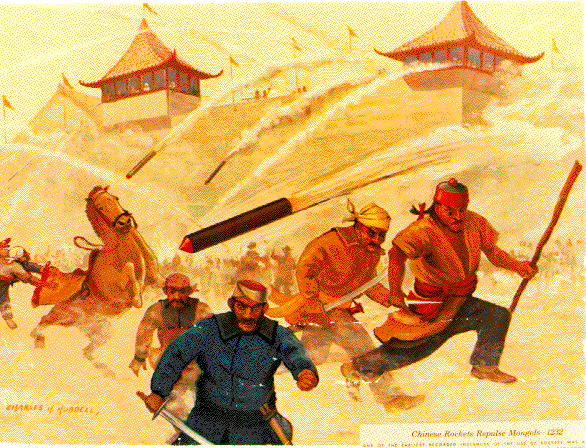Juan David's Newsletter - October 30th, 2022
Early History of Rockets (and the forgotten Rocket-Powered Flying Chair)
Hi there,
On Friday, my friend and I created a meetup with cool people. I thought about cool people and messaged them to meet at a specific place at a specific time. About 30 people came and it was a lot of fun! I find it surprising that these conversations always shift to the heart: existentialism and meaning.
Today we’re talking about the early history of rockets.
Early History of Rockets (and the forgotten Rocket-Powered Flying Chair)
This essay draft is part of an upcoming mega essay (or book) of an exploration of teaching myself EVERYTHING on Flying from Hidden History to Hardcore Engineering.
Rockets are the best example of how humans can see farther and do more once standing on the shoulders of those who came before them. There are thousands and thousands of years of trial and error and the human grit of trying and trying and never giving up. Years later, we get rockets! But how?!!
It’s hard to find “the first” rocket or the first device that used rocket principles, but there is a tale of a wooden bird who successfully exploited the essentials of rocket flight. There’s a story of the Greek Archytas around 400 B.C. who flew a pigeon made of wood, and the escaping steam propelled the bird suspended on wires. This pigeon used the action-reaction principle, later stated as a scientific law in the 17th century.
And there are more of these tales, but it needs to be clarified when the first actual rocket appeared because there are stories of early rocket devices appearing worldwide. Perhaps the first rockets came as accidents, as in the first century A.D., the Chinese created a simple form of gunpowder to create explosions during religious festivals. They would put the gunpowder inside bamboo tubes, and perhaps some failed to explode and started moving quickly with fire, propelled by the gases from the burning gunpowder.
The Chinese realized this and began attaching the gunpowder-filled bamboo to arrows and launching them with bows. But they realized these bamboo tubes could launch themselves just by the power produced by the gas escaping. This type of rocket design is a solid-propellent rocket, which we’ll learn more about later.
This was the beginning of what we now call a rocket.
The first reported use was in 1232 when the Chinese and the Mongols were fighting the battle of Kai-Keng. The Chinese were successful because they could use their “rockets” to scare the Mongols away. How successful were these rockets? No one knows, but it surely scared the Mongols because following this battle, the Mongols started producing their rockets and perhaps the ones who started the spread of rockets throughout Europe.
After this battle, many reports of rocket experiments followed from the 13th and 15th centuries. Experiments range from improving range to designing predecessors of weapons such as the bazooka.
By the 16th century, rockets became a weapon of war, but they were still used for fireworks. In Germany, a fireworks maker, Johann Schmidlap, invented the “step rocket,” meaning a rocket inside a rocket. The purpose of this multi-stage rocket was to reach higher altitudes, and the first stage would start and burn out, and then the second stage would continue going up. Remember, Schmidlap’s idea is essential to all outer-space rockets.
Another exception to rockets primarily used for wars was this Chinese legend of using a rocket-powered flying chair. There was a chair with two large kits attached to the kites; there were 47 fire-arrow rockets.
While it made for a great picture, people have yet to learn what happened after the chair took off. If this legend is, in fact, real, they were probably blown to pieces. This may look ridiculous, but these people wanted to try and could do so if they wanted. No regulations or anything else prevented adventures from trying out their experiments.
Rocketry was all experiments; no one understood why and how they worked—this somewhat prevented progress. But in the 17th century, Isaac Newton put his understanding of physical notions into three scientific laws.
Newton’s laws were vital because they explained how they work and, more importantly, how much they guided the design of future rockets.
During the end of the 18th and the beginning of the 19th century, rockets had a “comeback” and started being used as a weapon of war again. The success of Indian rockets against the British in 172 caught the interest of British Colonel William Congreve, who set out to design rockets for the British military.
Congreve rockets were successful, but the accuracy had remained the same even since the early days. Imagine controlling an explosion and landing it with a target. DIFFICULT!!!!
Still, war rockets were effective because they would launch these rockets in big numbers. In a typical siege, thousands of rockets might be fired at the enemy. Accuracy and power? Not that important yet.
But accuracy was still bothersome, and researchers worldwide thought hard about the question. William Hale was one of these researchers who came up with spin stabilization, where the escaping exhaust gases struck small vanes at the bottom of the rocket, causing it to spin as a bullet does in flight. This method is fundamental, and improvements of the technique are still used today.
Rockets continued to be used successfully in battles all over Europe until the Austrians rocket brigade in a war with Prussia (modern-day Germany) could not really compete with new weapons such as the Breech-loading cannon and exploding warheads. These new weapons were far more effective than the best rockets.
And just like that, rockets became ineffective for war and were dismissed for a while, leaving the experimenters and curious people at the time to continue iterating.
Rockets and space? That was far, far from being a reality.
It was only until science fiction writers started writing about outer space rockets that scientists started thinking about whether it was possible. It turns out rockets could go to space.
And that’s a story for the next time.
UIUCFreeFood reached 1000 followers this week with a whopping consistency of 200,000 impressions as well as 100,000 profile visits. Wild!
While that’s cool, it’s a lot cooler to hear how much it’s helping students.

I didn’t think food insecurity was as deep as it is, some students have told me they check the page every day and without it, they wouldn’t have been able to eat.
I’d like to continue helping students (most students aren’t on Twitter) so I want to increase accessibility such as Discord, Instagram, etc as well as start a bigger effort to recruit volunteers/paid students to go to restaurants/dining halls to collect untouched food and give it to students who need it. I don’t need that much money but some, if you know of any grants or are feeling generous, reply to this email.
Best Regards,
Juan David Campolargo
🎵 Song I listened to while writing this: Run Into Trouble. I’m sure Bastille will show up a lot in my 2022 Spotify playlist. Check out my favorite songs of 2021.








